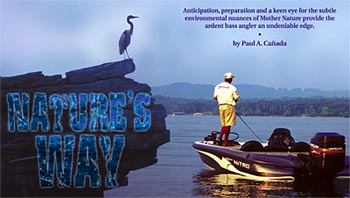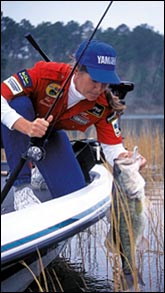
Anticipation, preparation and a keen eye
for the subtle environmental nuances of Mother Nature
provide the ardent bass angler an undeniable edge.
By Paul A. Cañada
Page 2
Subtle Signs and Adjustments
Experienced anglers know the bass is extremely sensitive to changes in its environment. Many of these environmental changes-as subtle as the angle of the sun-cause the bass to relate to cover and structure differently. Again, those anglers who recognize these changes and make the right adjustments in presentation are able to maintain contact with the fish.
"The key almost always comes down to making the right adjustments," shares Klein. "And that requires an intense awareness. When I start getting in that mental state, watch out. Good things start happening. Every decision seems like the right decision."
 With the exception of water temperature, it seems nothing affects a bass' feeding activity or association with cover and structure as does light penetration. Many factors-water clarity, cloud cover, surface disturbance and the sun's position in the sky-determine the depth light penetrates. So it reasons, the angler who notices a change in cloud cover or wind direction and intensity is able to make adjustments in presentation that correspond accordingly with changes the bass make in relation to changing light penetration. With the exception of water temperature, it seems nothing affects a bass' feeding activity or association with cover and structure as does light penetration. Many factors-water clarity, cloud cover, surface disturbance and the sun's position in the sky-determine the depth light penetrates. So it reasons, the angler who notices a change in cloud cover or wind direction and intensity is able to make adjustments in presentation that correspond accordingly with changes the bass make in relation to changing light penetration.
Typically, the greater the light penetration, the deeper the bass move, or the more cover-oriented the fish become. Conversely, bass tend to be relatively shallow and actively feeding during periods of low light penetration. Understandably, wind agitating the water surface and decreasing light penetration encourage bass to move shallow to feed.
As Parker's experience demonstrated, tidal changes often result in changes in the bass' activity level and the way the predator relates to cover. Similarly, water being drawn from reservoirs, for power generation or flood abatement, also impacts bass behavior.
Sensing the water movement and dropping water levels, shallow bass often move to the nearest break or drop-off and suspend. Although this is one of the toughest of the environmental changes to detect, the evidence of immediate draw-down can often be found along the shoreline.
Going to the Birds
As previously mentioned, not all anglers are able to recognize the more subtle clues or changes. However, a group of sunfish rushing recklessly at a bank or a scattering school of shad are obvious enough for most bass anglers to see and understand. According to Klein, clues like these abound in Nature, and they tip anglers to obvious feeding activity.
"As I am fishing," explains Klein, "I watch for any activity along the bank or in the water itself. Often, while moving along a bank, you will see or hear a small group of minnows scatter or a sunfish bolt. Other times, you might see a twig, lily pad or reed move and know something big moved. I can't tell you how many times I have flipped to an area where a twig just moved and hooked up with a big bass."
As was the case during Klein's victory on Lake Okeechobee, birds can help anglers identify zones of activity. Large wading birds such as great blue herons will feed on baitfish, sunfish and small bass while slowly wading along a bank, or by dropping from a perch. Diving birds such as cormorants (a.k.a. "water turkeys"), grebes and loons, working along a bank, often help anglers identify areas of baitfish activity.
During a recent fishing trip on California's Lake Oroville, Klein watched as a group of Western grebes painstakingly worked over deep water. The 2-time B.A.S.S. Angler of the Year was marking spotted bass and pond smelt along the bottom at 65 feet.
Klein found it strange that the birds would dive so deep, and began timing dives. He concluded that because the birds consistently stayed down for as long as a 50 count, they were likely feeding on pond smelt driven up by bass.
Both Parker and Klein agree that reading Nature's way is often the key to angling success. "There's a tremendous number of signs and clues, if we're just willing to actively listen and watch," Klein concludes. "Some of the clues help us find activity-whether it be feeding bass or the presence of baitfish-while others tip us to changes in the bass' environment.
"Both deserve our attention."
Preparing for Change
Like Texas weather, bass patterns are guaranteed to change. Although most anglers acknowledge this, few prepare for it. During critical times, they find themselves with the wrong line or hook size, or too light or heavy a worm weight. Other times, they're missing a key color or bait size.
Tournament anglers and guides have learned, through years of on-water experience, to be prepared for the most extreme changes possible. By keeping an eye on recent and upcoming weather, and by staying up-to-date on water conditions, experienced anglers have a good idea of what's possible. They allow for windy and calm days, bright and overcast skies, and, of course, inactive bass.
Having thoroughly thought out all possibilities, experienced anglers prep their tackle, rods and reels and boats. Having prepared the night before, there are few surprises and very little wasted time.
In fact, the pre-trip preparation helps put the angler in a mood of anticipation which helps the experienced angler to be more observant of the environment.
That anticipation and observation usually pays off big-time.
# # # #
page 1 / page 2
| 




